David L. Shenkenberg, News Editor
Many scientists carry out all of their research in the lab. Others leave the lab to go on adventures. Some of the men and women who study bacteria that thrive in extreme conditions live like Indiana Jones – giving lectures one day and cave-diving or investigating an active volcano the next.
Jim Holden and his group from the University of Massachusetts Amherst embark upon a ship called the Atlantis for a location in the Pacific Ocean that is 200 km (124.27 miles) off the coast of Washington state and British Columbia. They ride the submarine Alvin down 2200 m (1.37 miles) below sea level to an area of the ocean floor known as the Endeavor segment of the Juan de Fuca Ridge. There, two plates of Earth’s crust shift, and lava erupts from the cracks. Although Holden has been miles from dry land and almost 1 1/2 miles below the ocean surface, he has never feared for his life while on these excursions.
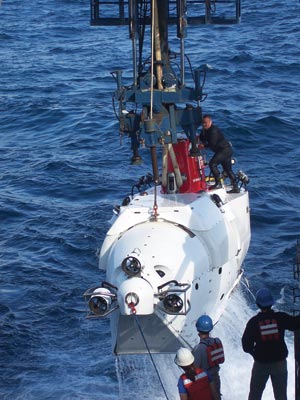
Scientists haul the Alvin from the ocean after a dive. Courtesy of J. Holden.
“The ride to the bottom usually includes a trip through bioluminescent organisms a couple hundred meters below the surface that create bursts of blue-green light against a completely black backdrop. When the sub reaches the bottom and the lights are turned on, the first thing you see is cold black lava from previous eruptions. We follow this to the actual vent sites, where suddenly there is an explosion of life, color and activity swirling around these jets of hot black fluid rising out of the sea floor,” Holden recalled.
With no sunlight reaching the ocean floor, scientists once thought it barren of life. Surprisingly, giant worms, mussels and plants live on it and, even more amazingly, thrive amongst volcanic eruptions. Even though the ocean cools the lava, turning it black, the liquid still emerges from the floor at a temperature up to four times the boiling point of water.
It turns out that animals and plants living near the ocean floor benefit from bacteria that convert sulfur from the volcanic eruptions into food. The process is akin to photosynthesis but doesn’t require sunlight. The bacteria have been found to live inside the giant worms in a mutually beneficial relationship.
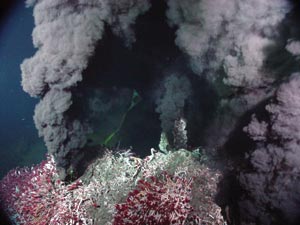
Black smoke comes out of volcanic vents in the Endeavor segment of the ocean floor. Courtesy of the University of Washington.
Funny smell
The Alvin takes pictures of undersea life using a Sony video camera and several digital still cameras – the Canon G2 and G7 and the Nikon D1. To measure the sizes of the plants and animals in the images, one of the cameras has a couple of laser pointers attached.
Holden said that the researchers who use the submarine want to move to high-definition cameras. Although Alvin has been around since the 1960s, the equipment has changed frequently to keep pace with the latest technology.
The sub illuminates the ocean floor with quartz iodide and metal halide lights. On the exterior are two robotic arms and a collection basket that can carry up to 680 kg (1500 lb) of tools and samples.
The Alvin is owned by the US Navy and is maintained by Woods Hole Oceanographic Institution in Massachusetts, but marine scientists from other institutions can use it also. Technically, it is more a manned submersible than it is a submarine. It is smaller than a submarine and can dive down deeper.
Although the investigators who ride the ship Atlantis and the submersible Alvin experience the journey of a lifetime, the trip has its less glamorous moments. Once the samples are transferred from Alvin’s collection basket onto the ship, the researchers must inhale the overpowering aroma of the hydrogen sulfide that was consumed by the bacteria. What does hydrogen sulfide smell like Imagine the scent of rotten eggs.
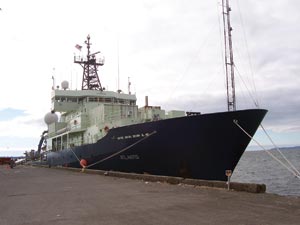
Holden and his crew take the Atlantis out on the Pacific Ocean. Courtesy of J. Holden.
The group members work hard to sort through the samples in a short time. They can deep-freeze some of the bacteria indefinitely; the remaining samples require transfer to new growth media every once in a while.
Extraterrestrial
The proteins that allow these bacteria and other organisms to survive in extreme heat may serve in industrial processes, many of which already use enzymes. However, because the enzymes used currently cannot withstand heat, they cannot be used in combination with manufacturing methods that involve heat.
Astoundingly, these bacteria can consume cellulose, a sugar in plants that humans cannot digest, and turn it into hydrogen gas. Holden’s group has been screening the bacteria to find out whether cellulose can be converted into hydrogen gas in a single step.
By efficiently making hydrogen from readily available plant material, these oceanic bacteria might lower the cost of producing hydrogen as a fuel. Cars using hydrogen as fuel already have been built and may become more popular with time. Someday these bacteria may help reduce the US’s dependence on foreign oil.
To paraphrase Holden, these bacteria contain many unknown enzymes, which could do all sorts of things. Scientists must find out just what those things are. He plans to acquire an imaging device called a microarray scanner to study the DNA that encodes for these unique enzymes.
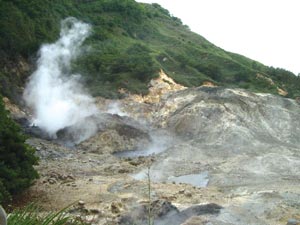
The researchers also travel to the isle of St. Lucia, a tropical paradise in the Caribbean. Courtesy of L. Feinberg and J. Holden.
Researchers, most notably Carl R. Woese at the University of Illinois at Urbana-Champaign, have found that the RNA of these organisms differs greatly from that of bacteria living in less extreme temperatures. Investigators like Woese have concluded that they actually belong to a separate classification of single-celled organisms called the Archaea.
The Archaea include bacterialike organisms that thrive in all kinds of unusual conditions in addition to extreme heat and that collectively are known as extremophiles. They are believed to have evolved eons ago and may reveal how life could exist on planets besides Earth.
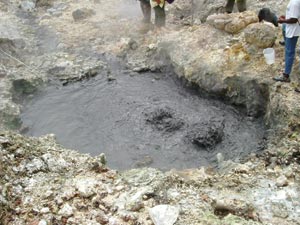
Close-up of a hot spring on the isle of St. Lucia. Courtesy of L. Feinberg and J. Holden.
The bacterialike organisms that love extreme heat – hyperthermophiles – have been found in hot springs as well as in the deep ocean. In fact, now-retired professor Thomas D. Brock and his group from the University of Wisconsin-Madison discovered hyperthermophiles in the hot springs of Yellowstone National Park in 1966. Holden and his crew have ventured to the tropical paradise of St. Lucia in the Caribbean to collect bacteria from hot springs there.